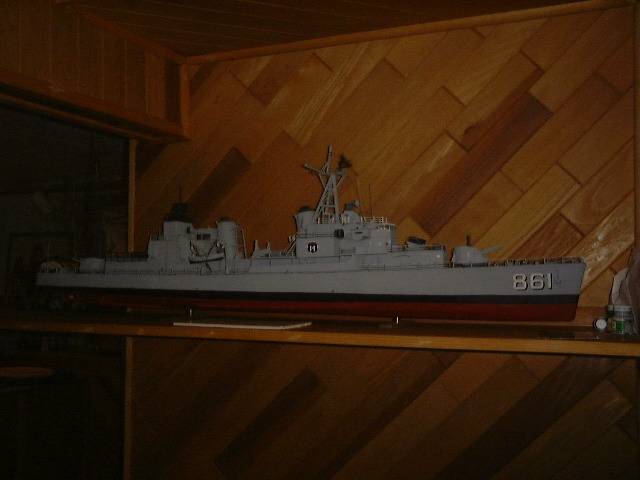
This model of the USS Harwood is made of wood and was for many years on display in the Jacksonville Maritime Museum in Jacksonville, Florida. It was made from scratch, using photos, by E. Scott Bushnell and is approximately 51 inches long.

Next a frame was made up of several pieces of poplar wood. The frame was then covered with 1/16" balsa wood and given three coats of varnish with extensive steel wooling and sanding between coats. Extreme care had to be taken in the initial stages as the balso was quite fragile. Next, the roll boards and shaft struts were added.
Before I could paint the hull several pieces of deck furniture needed to be added. In addition to fitting the main deck (made from 3/32ndh in. balsa), hawsepipe lips and anchor chain locker lips (formed from liquid balsa) were carved and glued on. Once these items were in place I was able to spray paint the entire hull and main deck with three coats of Polly S equipment gray, sanding between coats.
The topside superstructure is made from balsa, boxwood, brass and plastic - using whatever material best lent itself to the task at hand. MOst of the bulkheads and decks are 1/16 or 3/32nd balsa finished in the same manner as the hull. The stacks are block balsa carved and sanded to shape while the tops are dowels bored out. Spackle was used to provide the flare from the top to the stack. The propeller fenders were made from brass and soldered to shape over a form I made.
Extensive detailing of the superstructure was made possible using HO scale fittings (ladders, wheels, grab irons, etc) Brass wire and brass tubing was used for the stanchions and water wash down system. Hanger deck drop nets were made from brass and nylon mesh.
The trainable hedge hog mount, two 5"/.38 cal gunmounts and the director mount and radar are made from plans obtained from Floating Drydock out of 1/16th in. balsa. The gun barrels are bored and shaped dowels. The entire project took slightly over three years.